23. Jan 2018 - DOI 10.25626/0079
Dr Ekaterina Makhotina is assistant professor for East European History at the University of Bonn, Germany. Her fields of research include remembrance of WWII, Stalinism and Holocaust in Russia and Eastern Europa. She obtained her PhD at the University of Munich. Her thesis on the War Commemoration in Soviet- and Post-Soviet Lithuania was awarded the Peregrinus-Prize of the Bavarian Academy of Science in 2017. She is now working on a project on monastery prisons in Russia in early modern times.
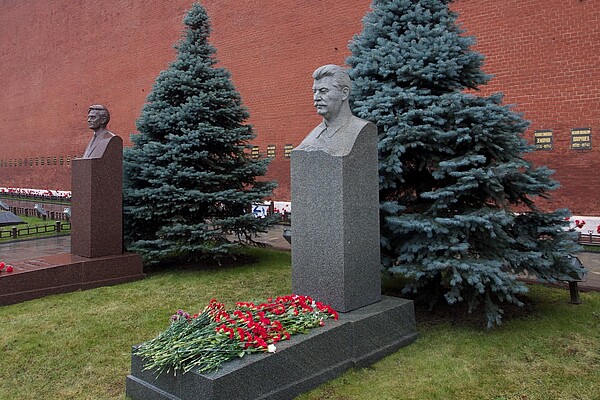
Since the fall of the Soviet Union, Russia has held memorial ceremonies to the victims of political repression on 30 October of every year. This year, 30 October 2017, a week before the centenary of the October Revolution, President Vladimir Putin unveiled the “Wall of Grief” by sculptor Georgy Frangulyan. Located on prime real estate in Moscow, the monument is the first large undertaking of the foundation Fond Uvekovechenija pamjati zhertv politicheskich repressij [Eternalization of the Memory of the Victims of Political Repression]. Approved by President Putin in 2015, the foundation’s board counts many prominent people among its members.[1] The monument was financed by both the state and the foundation, with the state contributing the larger portion of funds.[2]
In his dedication, Putin did not mention the instigator of the repression—Joseph Stalin—by name. Nevertheless, Stalin plays a more dominant role in contemporary public debate on Soviet history and Russian society than any other historical personality, even in the centennial year of the October Revolution.[3] A good example of this are the findings of a survey conducted by the Levada Center that showed that Stalin is seen by many as “the greatest person in Russian history.” The addition of a bust of Stalin alongside 33 other leaders at the “Alley of Rulers” near Moscow’s Military Uniform Museum also attests to this, as does a recently restored plaque dedicated to Stalin at the Kutafin Moscow State Law University. Both inside and outside of Russia, some have even spoken of a “Stalin cult”.[4]
On all accounts, the Soviet dictator who died 64 years ago has remained alive and well in Russia’s collective memory, a feature of a past that refuses to pass. The well-known title of historian Mikhail Gefter’s 1988 article “Stalin Died Yesterday"[5] thus remains relevant. And then there is the so-called “Stalin Renaissance” or “Stalin Trend”.[6] This makes it all the more astonishing that there is little contemporary discussion on what this ‘memory’ is all about, why it has come to take the shape that it does, and if it even qualifies as a ‘memory’. In this sense, many of the phenomena mentioned might be interpreted as modes of medializing Stalin’s popularity, which is the topic of this article. Is this medialization part of an officially supported ‘creeping rehabilitation’ of Stalinism, as many have surmised? Or is it more a matter of projection of the desires of Russian society?
In 2017, it seems to have become a matter of consensus that the Socialist Revolution is worn out as far as intellectual life goes. Of course, Lenin has remained a popular symbol of historical kitsch and Lenin memorabilia sell in droves in the souvenir shops; Lenin’s Mausoleum is still a major tourist attraction. But even for the Communist Party, the ‘leader of the world’s proletariat’ is now little more than an indispensable symbol. As far as real political praxis goes, the Communist Party of the Russian Federation (CPRF) prefers Stalinist methods. At first glance, it might seem odd that the ‘left’ in Russia places Stalin over Lenin, but if one studies the ideology of today’s CPRF, the ambivalence that permeates the party’s program becomes clear. In short, their ideology is steeped in (national-)conservatism and nostalgia for the Soviet era; they reject ‘revolution’ as a means of political action. On the other hand, the Communists cannot simply condemn the leader of the Socialist Revolution and the ‘Red October’, the founding myth of the Soviet state.
The October Revolution does play a central role in the rhetoric of Russia’s contemporary Communist Party, but it functions more as an object of nostalgia and less as a symbol of a vision for the future. The party’s ideology is not centered on Lenin’s internationalist convictions— expressed most pointedly in his statement: “To hell with it … All this is only the road to a World Revolution”—but on the ‘victorious’ period under Stalin and the ‘stable’ years under Brezhnev. According to this narrative the October Revolution’s becomes significant in the fact that it brought forth the Soviet system, which ‘made Russia great’ and allowed her to defeat Hitler.
In order to better understand the rhetoric, it might help to take a look at the CPRF’s position within the system of Russian party politics. The basic contours of Russian politics were shaped in the first post-Soviet years, but they became crystallized in the paternalistic discourse of stability in the 2000s. During this period, the Communist Party tried to broaden its base by doing things like appealing to religious sentiments and using imperialistic, patriotic rhetoric. Over the last 18 years, the Communists have constituted a stable ‘opposition’ to the ruling United Russia party, receiving anywhere from 12% to 19% of the vote.[7] The Communists see their commitment to traditional, national values and narratives as a strategy that promises success, and in order to scoop up more votes, they have sought to integrate conservative ideas and Soviet nostalgia into their party ideology. In doing so, the CPRF has sought to become a party for ‘Soviet nostalgics’ of all stripes. By making Stalin’s victory in the Second World War (one of the Communists’ popular slogans is “We’re bringing back the victorious era!”) and the period of ‘stability’ under Brezhnev into key points of reference, the CPRF has been able to garner support from wide swaths of the population, including nationalists. Hardly anyone today seeks to draw on the internationalist orientation of Leninism, while the nationalist (and imperialist), chauvinist ideology of Stalin has become a bedrock of CPRF thought. Stylized as a ‘great leader’ and ‘just ruler’, it is Stalin who has been made into a symbol of the critique of capitalism. In using images of Stalin on their anti-corruption campaign posters, the Communists seek to juxtapose ‘order’ under Stalin against the ‘unhindered’, ‘corrupt’ capitalism that serves the interests of the West. Thus, with Stalin as their symbol, the Communists call on Russians to help reinstitute order and join the fight against corruption in the Kremlin. Visions of social justice seem to have little appeal for the majority of young Russians interested in consumption and quick profits.
The plaque dedicated to Stalin at the Kutafin Moscow State Law University is one of many private initiatives to install memorials to Stalin throughout the country. According to Moscow-based anthropologist Alexandra Arkhipova, who has been studying Stalin’s popularity in society for years, 132 memorials and plaques dedicated to Stalin have been erected since 1998, most of which were commissioned either by private individuals or, in the great majority of cases, the CPRF.[8]
In contrast, the government has seldom lent its support to the erection of Stalin memorials.[9] The most prominent examples are the Stalin Museum in Tver Oblast near Rzhev, housed in a cabin where Stalin spent a night in 1943,[10] and the above-mentioned bust of Stalin in the courtyard of the Military Uniform Museum. Both were initiatives of the partially state-funded Russian Military History Society (Rossiiskoe voenno-istoricheskoe obshchestvo, RVIO) and received support from the Ministry of Culture.[11]
Still, the conspicuous presence of Stalin symbols in public spaces might lead one to think that Russia’s political leadership is also working on churning up social support for the rehabilitation of Stalin, and not without a little success. But to what extent is this really the case?
Three widespread but misleading opinions are deserving of critical attention here. First is the claim that the rehabilitation of Stalin is a new phenomenon. The associated notion that there was wide, anti-Stalinist consensus in the late 1980s and early 1990s is, however, deceptive.[12] The Stalinists, or those who were simply indifferent towards the massive repression of the 1930s, were still around in the early 1990s, but people who retained a positive opinion of Stalin were simply less present in public life.[13] And although the Gulag and the Great Purge were prominent topics in the now liberalized press, this was in large part a discourse of the elites.[14] The declining economic and social status of large swaths of the Russian population led to an increase in nostalgia for the Soviet era and a strong leader like Stalin.[15] Even the valorization of Russia’s victory in the Second World War, which received official support from Boris Yeltsin,[16] revived, nolens volens, positive associations with its ‘father’. According to a sociological survey conducted in 2003, Stalin was the most popular of all past Russian rulers, with 53% of respondents giving a positive vote.[17]
Second, the notion that many are unaware of the extent of political repression during the Stalin era or that speaking about it is taboo should be relativized. The persecution of peasants during the forced collectivization of agriculture, the famine of 1932–33, and the purge of the party have been taught in public schools since the 1990s,[18] and since 2013 have been made into a requirement for history textbooks as part of the so-called “historical-cultural standards”.[19] These topics are also addressed in museum exhibitions, film, and literature.[20] People interested in the history of Stalinism can learn about it on the website of the Memorial Foundation, the website of the Virtual Gulag Museum and the website Uroki Istorii (“Lessons of History”). According to a recent survey, the number of those who know about these events doubles the number of those who do not.[21] Thus, one can safely say that the current popularity of Stalin cannot be attributed to the state making Stalin’s crimes a taboo topic. Even Stalin’s greatest contemporary follower, current General Secretary of the Communist Party Gennady Zyuganov, said in 2011 that “during the 20 years of Stalin’s rule, 15 million were repressed.”[22] It seems that knowledge of mass repression does not stand in the way of admiration for Stalin.
So why are people venerating Stalin despite the fact that they are aware of the terror he unleashed? One explanation might be the gap between ‘learned’ and ‘felt’ history. The mention of Stalin’s name triggers a strong affective reaction. As sociologists have demonstrated in multiple studies, much of contemporary Russians’ knowledge of history is often based on emotional impressions of what happened in the past. In other words, many people tend to form judgments based on ‘affects’ and less on a serious reckoning with the significance of events.[23] Knowledge about the repressive measures used by Stalin taught at school has failed to leave a real mark on the historical awareness of many Russians. Instead, emotions of pride stirred up by events like those held on Victory Day seem to have a greater influence on how history is understood.
Third, the widespread notion that the Kremlin has propagated a positive evaluation of the Stalinist legacy should be viewed with some skepticism. President Putin’s public statements about Stalin leave little room for interpretation. He has said that the Stalinist form of government was intolerable, that Stalinism was responsible for crimes committed against millions of Soviet citizens, and that the price of industrialization was much too high.[24] Much attention was paid to a video recorded in 2009 by then-president Dmitry Medvedev titled “Memory of National Tragedies is as Sacred as the Memory of Victories”.[25] In the video, Medvedev underscored the importance of remembering political repression and criticized all attempts to justify or relativize Stalin’s crimes. The highpoint of official state memorialization of the victims of repression has been the “Wall of Grief” discussed at the beginning of this article.
But despite political leaders’ negative public statements about Stalin, there has still been no legal reckoning with Stalin’s legacy. Moreover, the rise in the government’s use of nationalist-patriotic rhetoric since the 2011–13 Russian protests has been geared towards gaining more support from nationalist, conservative forces. This tension reveals quite clearly the populism of the Kremlin’s politics of history: The state criticizes Stalinism, but at the same time, it contributes to a political climate in which public display of Stalin’s portrait (during demonstrations, for example) goes unpunished. The state does not even castigate the ‘Stalinists’ in word, much less in deed, and they are allowed to spread their message on state-funded television. The newest nationalist organizations, such as Essence of Time (Sut’ Vremeni), Night Wolves, and SERB (South East Radical Block) have become known for harassing organizers seeking to raise awareness about political issues and liberal politicians and journalists who take a critical perspective on Russian history. The symbols used by these groups draw on the emotional capital of the Stalin cult. Today, nationalist groups are organizing more and more local initiatives that decry historical education and deploy various methods to suppress it. These groups use their contacts in local and regional politics in their attempts to cut off public funding for initiatives that seek to inform the public about the history of Stalinism.[26]
How is Stalin used by social movements? Moscow-based anthropologist Alexandra Arkhipova studied the use of Stalin as a symbol in protests in the year 2017. Portraits and other images of Stalin were used during the mass protests against corruption held in many Russian cities in 2017. In the spring of 2017, organizers of a petition against raising rents for socially subsidized apartments in Novosibirsk collected money for a “mobile” bust of Stalin.[27] According to Arkhipova, Stalin is used as a symbol for many different “anti-positions”: anti-corruption, against the inertia of political elites, anti-rightist politics, and, in general, anti-failure. In other words, he functions as a symbol of an idealized sense of order, the possibility of deposing (!) leaders, for justice, for a state that cares, and even successful leadership. Many have come to support the notion that the forward steps made in industry and the military were worth the price—namely, thousands of human lives. According to this way of thinking, the methods, cruel as they were, were not as important as the achievements they brought. Arkhipova argues that in all kinds of contexts, Stalin is ultimately being used as a symbol of the opposition between the bad of today and the good of yesterday.[28]
Nevertheless, she qualifies this claim, adding that the instruments available for putting forth one’s own interests in contemporary Russia and the limited range of ways of exerting influence on power play an important role here. Joining a demonstration is often a matter of last resort, and the more provocative the slogan, the better the chances are that one will be heard.
It might also be the case that in tough times, paternalistic positions see an uptick in popularity more generally. The number of Stalin memorials erected during the last few years was 2.5 times higher than during the ‘rich’ years between 2006 and 2009.[29] A precarious economic situation, increased sensitivity towards social injustice, perceptions of an increased gap between rich and poor, and an opaque, corrupt bureaucracy have given occasion to nostalgia for more certain times and ‘someone who gets things done’. To say it once more: those who come to embrace Stalin for these reasons are motivated by exclusively emotional factors, ignoring the information available on Stalinism and transforming Stalin from a real historical person into a symbol that can be used for a multitude of purposes.
In short, critical observation of social practices reveals that Stalin has become a universal symbol and metaphor in divergent contexts. The disappointments of the present lead people to search for something better in the past. The more corruption and rightist nihilism become aspects of everyday life, the more popular the figure of Stalin becomes. Finally, Stalin has become commonly used in memes on the internet, as the meme called “Dark Humor” exemplifies (see picture).
Reports on the findings of the June 2017 survey that found Stalin to have been the most popular of Russia’s past rulers among respondents dominated the waves for weeks, a fact that might lead one to conclude that ‘Stalin sells’. However, I think the important question is not whether the Russian state under Putin’s leadership is rehabilitating Stalin, but rather how the state is using Stalin’s popularity for its own (populist) aims.
If we let survey data serve as a rough indicator of Russian society’s view of Stalin, the trend is clear: about a quarter have a positive opinion of Stalin, about a quarter have a wholly negative opinion of him, and about half are undecided.[30] The decisive question is then whether that indifferent half will ever veer towards a positive or negative view of Stalin and what influence state media would have on this switch.
Surveys are often cited that show that people have a positive view of Stalin, but one rarely reads of surveys that show that hardly anyone would have wanted to live under Stalin’s rule. The media likes to reproduce the widespread belief that Stalin would have narrowly won the “The Name of Russia” competition in 2008 were it not for manipulation from ‘above’ that gave Prince Alexander Nevsky the edge.[31] The point of the manipulation, it is claimed, is to send a signal both at home and abroad that those in power are ashamed of the Stalinists and want to take up a ‘liberal’ position.
Moscow-based political scientist Ekaterina Shulman thinks that we should ask whether the medialization and scandalization of sympathy for Stalin in Russian society is beneficial to the Kremlin.[32] Shulman analyzes the media hype over the Stalin trend as an important way for the political elite to distance themselves from the Russian people, who they depict as a wild, bloodthirsty group that needs an iron fist to civilize and democratize it. She claims that doing so enables the government to present itself as the “only European” in Russia (Pushkin).[33] The media’s continued propagation of the image of an ideology-driven, religiously Orthodox, despotic society ultimately distorts the consumerist, secular, European values of the majority of the population. This reveals a politics of history that, while not quite populist, has sought to appeal to a broad audience. On the one hand, the population is depicted as being in need of ‘education’, a good example of which were the Orthodox protests that sought to ban the 2017 historical romance film 'Matilda'. On the other hand, the media simply say that Stalin ‘is part of history’.
Thus, the reasons for why Stalin has seen an increased presence in the media over the past few years are complex. They should be approached with a nuanced perspective that takes a close look at the precise ways that Stalin as symbol is used by the Kremlin. Accounting for the ways in which conservative and liberal forces have sought to accrue symbolic capital also goes a long way in explaining the medialization of the Stalin cult. The increased presence of Stalin cannot be traced back to an official rehabilitation of Stalin nor to a sort of re-Stalinization ‘from below’. Discussions of the ‘Stalin trend’ should thus focus on powerful groups’ discourse on Stalin and the benefits they draw from it as well as on the affective, emotional use of Stalin as a symbol.
Translated by Adam Bresnahan
Ekaterina Makhotina: Nostalgia, Pride and Shame: The Many Faces of Stalin in contemporary Russia. In: Cultures of History Forum (15.01.2018), DOI: 10.25626/79.
Copyright (c) 2018 by Imre Kertész Kolleg, all rights reserved. This work may be copied and redistributed for non-commercial, educational purposes, if permission is granted by the copyright holders. For permission please contact the editors.
A slightly shorter version of this article appeared under the title "Sehnsucht, Stolz und Schmach: Die vielen Gesichter Stalins" in the German language online-blog Erinnerung.hypotheses.org on 9 November 2017.
![Source: Пресс-служба Президента России (Kremlin.ru) [CC BY 3.0 (http://creativecommons.org/licenses/by/3.0)], via Wikimedia Commons](/fileadmin/_processed_/5/6/csm_Putin_-_Wall_of_Grief__2017__3__84f87fd621.jpg)
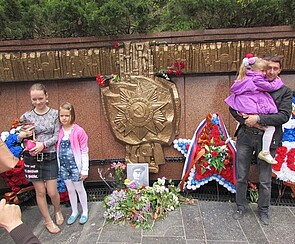
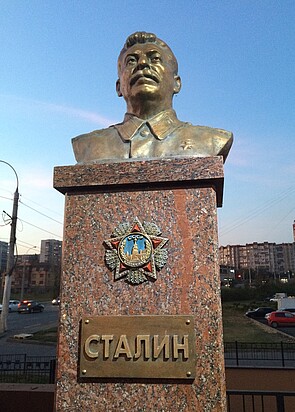
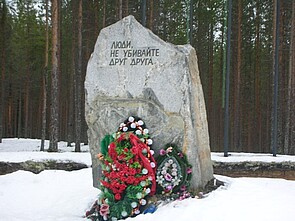
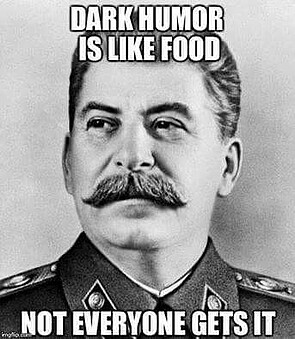
Jeremy Cohen · 25.01.2023
Vladimir versus Volodymyr: Conflicting Russian and Ukrainian Application of Rus’ Heritage
Read more
Violeta Davoliūtė · 01.06.2022
The Pop-Cultural Lineage of Russia’s Anti-Fascist Discourse: Unravelling the Plot of Putins’s War on...
Read more
Gero Fedtke · 27.08.2021
'Bukhenval'dskii nabat': The Life and Transformation of a Peace-Song in Soviet and Post-Soviet Histo...
Read more
Mykola Makhortykh · 28.06.2021
#givemebackmy90s: Memories of the First Post-Soviet Decade in Russia on Instagram and TikTok
Read more
Raphael Utz · 27.11.2020
Stalin in our Hearts. The Russian Film 'Sobibor' by Konstantin Khabensky
Read more
Get this article as PDF download (including pictures).